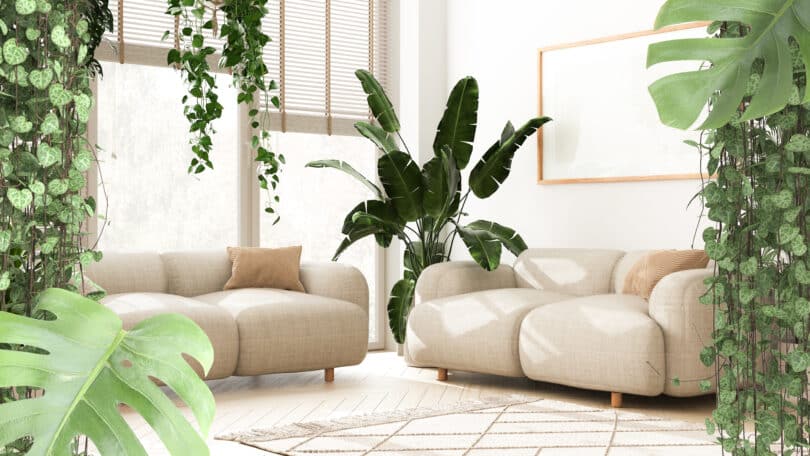The concept of biophilic design has emerged as a transformative approach to bridge the gap between the built environment and nature. Biophilic design seeks to incorporate elements of nature into our living and working spaces, promoting well-being, creativity, and a harmonious relationship with the environment. The principles of biophilic design have a myriad of benefits to offer individuals and communities.
What are biophilic design concepts?
Biophilic design is a concept that has been growing in popularity within the construction and interior design industries. It utilizes various qualities of nature such as sunlight, plants, and different spacing and layouts to bring key aspects of nature into urban environments. This applies to building-level and at city-wide scales. The idea behind biophilic design is that incorporating nature into our day-to-day spaces can have several health, environmental, and economic benefits, with very few downsides.
Although the term is more modern, the idea of biophilic design has been around for a long time. Evidence of such dates thousands of years to the animal-inspired designs in Egyptian architecture, flowering acanthus leaves on Greek temple columns, lotus ponds in ancient China, and the hanging gardens of Babylon.
The term “biophilia” was first coined in 1973 by psychoanalyst Erich Fromm. In his book The Anatomy of Human Destructiveness, he described biophilia as the “passionate love of life and of all that is alive…whether in a person, a plant, an idea, or a social group”, and claimed that it was a completely normal biological instinct. The word has since been used by many well-known scientists, professors, and philosophers, and has been adapted to several different areas of study. In 1984, biologist Edward O. Wilson detailed the “biophilia hypothesis” in his book Biophilia, which he stated was “the idea that humans have an inherited need to connect to nature and other biotic forms due to our evolutionary dependence on it for survival and personal fulfillment.”
Many modern researchers have come to the agreement that, although natural, the biological tendency to biophilia is somewhat weak, rather than other hard-wired instincts we have. To experience biophilia to its fullest, we must nurture this tendency through repeated contact with natural elements. In other words, the more we go outside, the more we enjoy going outside, and the more we allow ourselves to reap the benefits of various natural elements.
When it comes to biophilic design, the practice can be (and has been) applied pretty much anywhere – from residences to places of work, schools, and even healthcare facilities. Aside from the obvious inclusion of plants, it goes beyond that to include detailed planning of natural light, use of certain materials, color schemes, and textures, thoughtful consideration of room layouts and spatial configuration, and several other components that resemble elements of nature.
What are the benefits?

While there are several benefits to being better connected with nature, the primary focus of biophilic design centers around therapeutic benefits. Different features like natural light, greenery, the sound of running water, smell of plant life, have all been definitively linked to improved mental health and overall wellbeing. Being in nature, or at the very least, incorporating it in one’s everyday space, can do wonders improving mood and cognitive function, boosting creativity, and reducing stress levels.
A recent study conducted by the University of Melbourne found that adding plants into previously non-biophilic office spaces increased productivity by 15 percent. According to researchers, “The presence of natural elements, such as greenery and natural light, can stimulate the brain, improve concentration and foster a more conducive environment for problem-solving and creative thinking.”
Additionally, exposure to natural elements can have certain physical benefits as well. For example, natural lighting is essential to regulating circadian rhythms. In turn, this promotes better sleep patterns, and good sleep has a myriad of health benefits. Inadequate sleep can have a profound impact on one’s health. In the short-term, it can affect mood and judgement, the ability to learn and retain information, and it can increase the possibility of an accident or injury. Over a longer period of time, lack of sleep can lead to obesity, diabetes, cardiovascular disease, and even early death.
Access to natural light and outdoor views has also been associated with reduced symptoms of Seasonal Affective Disorder (SAD), and faster recovery times for patients in healthcare settings, regardless of what ailment they are suffering from (granted that it’s something curable/treatable). Because of this, it has become a growing trend to incorporate biophilic design elements into healthcare facilities. The natural materials and pleasing visuals can be beneficial to both the patients and healthcare professionals.
What does (or does not) constitute biophilic design?
The efficacy of biophilic design depends on several factors – mainly how well each aspect complements the space and other natural elements in the room. For example, adding a single small plant is not enough to produce results. Similarly, incorporating too many natural features that don’t harmonize well with each other can make a space too busy and overwhelming, thus defeating the purpose of biophilic design.
For example, biophilic design centers around natural elements that have been proven to be beneficial for humans throughout history. Once more, that includes natural light, the sound of running water, certain plants, etc. Exposure to natural elements that have been largely irrelevant to human survival and productivity are not considered to be part of true biophilic design.

It’s also important to note that successful biophilic design depends on repeated and consistent exposure to nature. Fleeting, isolated, or occasional experiences in the natural world do very little in terms of long-term health benefits, so it makes sense that when utilizing biophilic design principals, you’ll want to implement them in a space that gets regular and frequent use. Otherwise, the whole setup would be pointless.
Final thoughts
To summarize, we need our mother Earth. Exposure to nature can have some profoundly positive effects on our health and wellbeing. Although going to real nature is always going to be your best bet, if getting out regularly enough just isn’t in the cards for you, a close second would be to incorporating some biophilic design elements to your frequently used spaces.
Hello readers. We’re happy to have you with us at Cannadelics.com; a news source here to bring you the best in independent reporting for the growing cannabis and hallucinogen fields. Join us frequently to stay on top of everything, and subscribe to our Cannadelics Weekly Newsletter, for updates straight to your email. Check out some awesome promos for cannabis buds, smoking devices and equipment like vapes, edibles, cannabinoid compounds, amanita mushroom products, and a whole bunch more. Let’s all get stoned together!









